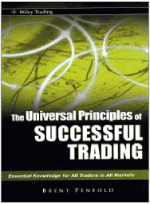A book review for Brent Penfold’s book “The Universal Principles of Successful Trading: Essential Knowledge for All Traders in All Markets”
This book is excellent for traders that are ready to accept its lessons. You need a foundation in trading to understand the importance of what the book is advising, and take the principles seriously with an open mind. Once you are through the rainbow and butterfly phase of trading, and realize that you will not be a millionaire in a year, this book will help you get focused and become serious about trading.
Here are the six universal principles of successful traders:
1). Preparation
Author Brent Penfold is in the minority, believing risk management is the #1 priority in trading. Brent believes that once you get your trading system and position size in place, you must use the amount you will risk on each trade to determine your risk of ruin. The book shows exactly how to figure this out using Excel. He believes that if your risk of ruin is not zero, then you will eventually blow out your account. Risking 1% to 2% of your capital in any one trade usually gives you a zero percent risk of ruin, but it also depends on your systems win/loss ratio. Make sure to test any system with a minimum of 30 trades and then determine your risk of ruin. I would advise a larger sample size in multiple market environments. A trend following system that looks brilliant in a trending market may result in a 50% draw down in a choppy or range bound market.
2). Enlightenment
Your most important goal is to lower your risk ruin to zero. In trading, the trader with the best ability to cut losses short wins. Simple trading strategies work the best based on traditional support and resistance levels, while trading with the trend on either reversals or break outs. The 10% of winning traders in the market win by treading where others fear; buying on break outs when they first occur, and going short when a new low is made. Buying into key reversals when a security finds support or resistance, and reverses at the end of a monster trend, is also a tactic of winning traders.
3). Developing a trading style
You must choose your own personal style of trading: swing trading, trend trading, etc. You must also trade based on your chosen time frame: intraday, short term, medium term, or long term.
4). Selecting Markets
Ideal markets to trade have high volume, price transparency, liquidity, 24 hour coverage, zero counter party risk, low transaction costs, and are honest and efficient. They also must have the necessary trading attributes of volatility, research, simplicity, ease of short selling, specialization, opportunities, growth, and leverage. These are the markets that afford you the greatest chances of making money.
5). The Three pillars of trading.
Money Management: You must make your trades as fixed as possible. Trade with the same risk, capital, units, percentage, and in the same type markets to manage risk most effectively.
Methodology: Choose a method that works for you and your personality. (Dow Theory, technical indicators, patterns, price and volume, etc) Once you have a methodology to your trading, test it in the real world, in real time, either with micro trades or paper trade. You need a sample size to judge its efficacy.
Trader Psychology: Manage your hope, greed, fear, and pain to stay in the game.
6). Putting it all together
Monitor your performance consistently. You need positive reinforcement that your trading methods are working, and this will be found within the results you are getting in winning and losing trades. Your equity momentum will show you if you are trading too big, or if you are on the wrong track. Your P&L does not lie.
I have been actively and successfully trading the market for more than a decade, and agree 100% with the principles found in this book. The author concludes by asking many professional traders what one piece of advice they would give to aspiring traders. This advice alone is worth the price of the book:
Money Management:
Focus on risk
Trade small
Methodology:
Pick a method that suits your personality
Develop a simple methodology
Avoid the majority, learn to anticipate reversals
Look for alignment in set ups
Good defense wins games
Identify low risk set ups
Know your methodology using software
Psychology:
Deep practice before trading
Expect to lose. Trade to win
Be disciplined. Be patient
Be humble
Be in control
[Tweet “Your P&L does not lie.“]
This book is the real deal. The author warns of the pains associated with trading. If you trade, you will experience those ten losing trades in a row in any system. You will experience the 10% draw down in your account. 90% of people who enter the markets will lose and quit. The majority of successful traders who win in the markets usually start out by losing most of the money in their first trading account. Be warned, the market uses maximum adversity at all times, so the majority of traders lose long term, surrendering their money to the minority that trade using winning principles.
This book is in the top twenty trading books I have read, and is a must for any serious trader’s library. I have not even scratched the surface of this excellent trading wisdom the author has shared. It is like combining all the best trading books wrapped into one. I would give this book six stars on Amazon if possible.
The Universal Principles of Successful Trading: Essential Knowledge for All Traders in All Markets
